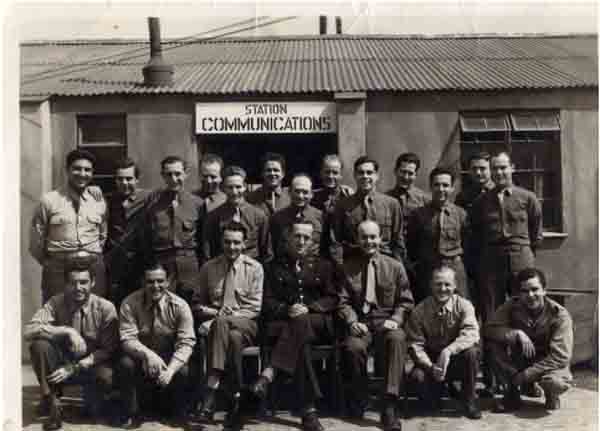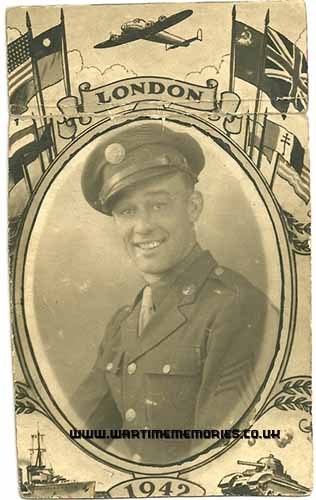I believe this might be a photo from Bovingdon 1942/43 when my father
was stationed there. Any leads will be most appreciated.
A history of the CCRC is available on microfilm.
Microfilm # B0797 (Unclassified) the history of 1st Combat Crew Replacement Center Group (covering the period Aug 42 - Nov 44) Bovingdon
It contains very useful information for any person who is interested in first hand accounts. Teh following is a transcription from that microfilm.
Relationship of 92nd group to Combat Crew Replacement and Training Center To tell accurately the story of the Combat Crew Replacement and Training Center reference must be made here, at the beginning, to the 92nd Heavy Bomb Group from which came most of the personnel for the school. This unit arrived in England during August of 1942, being the third American Heavy Bomb Group to be assigned to the European Theater of Operations. As a result of its flight to England the 92nd Bomb Group became the first complete organization to fly the non-stop, transoceanic route from Gander, Newfoundland to Prestwick, Scotland. The flight was made without loss and had a great deal to do with the general acceptance of this route for heavy bomber travel. The organization was led on this flight by Colonel James A. Sutton, Commanding Officer of the Group, and it was his brilliant leadership which was undoubtedly responsible for the successful completion of this mission. The unit was personally congratulated by General H. H. Arnold for this flight.
War Department
Headquarters of the Army Air Force
Washington
31 August 1942
Subject: Commendation
To: Colonel James A. Sutton
Commanding Officer
92nd Bomb Group (H)
Through Commanding General
U.S. Army Forces in the British Isles
1. I have just received the report that all airplanes of the 92nd Bomb Group have successfully completed their movement to England today.
2. I wish to commend you and all of the officers and men of the 92nd Bomb Group for your remarkable demonstration and accomplishment.
3. The safe execution of such a lengthy and hazardous crossing over a route previously unflown by any of the personnel of your group is indeed meritorious. The effort, hard work, and thought put forth by everyone of the 92nd Bomb Group in accomplishing this mission are indeed appreciated. I heartily congratulate you and your men.
H.H. ARNOLD
LT. GENERAL U.S.A.
COMMADING GENERAL
ARMY AIR FORCE
The aircraft flown to this theatre by the group were B-17Fs, the first of this type to be brought to this country. The B-17E was then being used by the 97th Bombardment Group.
The 92nd had worked hard on these ships, fitting them for the long flight and for the combat they were to eventually face. Many original modifications were made, several of which later appeared as standard equipment on the B-17G. Two changes of particular importance were: nose gun to fire directly forward (this later modified itself into the present "chin" turret), and radio guns fed from flexible bolts of 25 or 50 round ammunition cans.
The 92nd Bomb Group came to this country at the completion of its training in the United States expecting one thing: OPERATIONS-the chance to take on the enemy in the skies over Europe and to fight it out with him. It was with this single purpose in mind that the Group carried on its day to day existence; but upon arrival at this station, the unit was immediately ordered to exchange its new ships for the battle damaged ones of the gallant 97th Group. The personnel were then told by Lt. General Ira C. Eaker (then Major General), who was at that time Commanding general of the 8th Air Force, that they were to staff a training center for heavy bombardment crews. The loss of their planes was by the group taken more or less in stride, and repair and modification work began at once on the "beat up Es" inherited from the 97th. The men could see the obvious logic behind the exchange of planes, though of course they were not exactly happy about the idea; but to be taken out of the big fight without even hearing the sound of the bell was nearly a mortal blow to the morale of the organization.
"Why the 92nd Group?" Was The question in everyone's mind. The comments ran something like this: "We are not trained for this job!" "We don't know anything about combat yet!" "Why had we not been told before?" And even "What did we do wrong to draw this detail?" Some of the reasons "Why the 92nd?" later revealed themselves, but not all of them.
The airdrome to which the Group was assigned is located at Bovingdon, Hertfordshire and was designated as AAF Station 112. The field, which had been designed by RAF engineers as an operational base, was partially completed. With discontent everywhere the
men of the group went about this work of completing the field, setting up equipment for maintenance, organizing the system of supply, and generally solving the 'mud' problem. In their leisure time the discontented men fortunately had something very big to occupy their minds: a new country and a new people. There were things to find out: "How far was it to London?""What was a 'pub'?""Where was the nearest'cinema?""Just what were the English people like?"
"Did the sun ever shine?" "How much did a bike cost?"
"How much was that in real money?" "Can I get up to ....
and back on a forty-eight hour pass?" "I've got relatives up there that I have never seen". And so the queries ran. But despite the fascination of the new country, and the amount of hard work that was necessary to get the field going, the big thought in mind was still "Why the 92nd?" with its brother thought "What can we do to make them change their minds?" Colonel Sutton pledged himself to work unceasingly to have the organization reinstated for combat.
Permission was granted in September for the 92nd to take part in several combat missions in the interest of gathering necessary battle information to be taught in the school. Targets attacked by the Group were:
DATE TARGET LOSSES
4 September 1942 Meault, France 1
26 September 1942 Cherbourg, France 0
(diversion-airdrome)
DATE TARGET LOSSES
2 October 1942 Meault, France 0
9 October 1942 Lille, France 1
21 October 1942 Cherbourg, France 0
(diversion-airdrome)
Other groups flying on these raids included the 97th, 91st, and 301st bombardment Groups.
These five missions flown by the 92nd plus others being made at that time in which the 92nd did not participate were, however, bringing home to the group with great force, the seriousness of daylight high-altitude bombing. The missions also revealed dangerous weaknesses in the Group's combat technique. For example: they found their formations looked good to the eye of a camera, but did not permit maximum firepower for self defense. The aiming technique of the gunners was alright according to existing classroom ideas, but the enemy planes were not being hit. Navigation, because of radio aids and different weather conditions was full of new problems. The bombing technique proved itself to have an outstanding weakness, the pilots, through no fault of their own, found it nearly impossible to hold the plane level and true in the midst of fighter attacks and bursting flak. The bombardiers, bombing from an unstable platform, were not able to hit targets with true accuracy.
These combat weaknesses and many others showed themselves on those first missions, proving to the group the necessity for futher training, training to cover the gap between the generalization of the OUT schooling in the U.S and combat in the European Theatre of Operations. It was this advanced, fine-grain training that had been anticipated by General Eaker, and the assignment to set up the school for carrying out this training had been given to the 92nd Group. The assignment did not just concern itself with the training of the 92nd personnel, but rather with all combat crew replacements for the entire 8th Air Force.
It was a big assignment, worthy of the best efforts of a fine organization. The need for the school was then apparent to all, still the Group balked at the idea. The Combat anticipating hearts and minds of these men could not be reconciled to the monotonous duties of school teaching no matter what accompanying circumstances existed. It was decided, therefore, after much discussion within the organization and between representatives of the Group and General Eaker, that the Unit would be divided in two. Those interested in the school and necessary to the school would be assigned to it; those interested in combat and indispensable to the Group's operation as such a unit would be assigned to the Group. [Unsigned and No date shown]
This was transcribed from microfilm # B0797 (Unclassified) the history of
1st Combat Crew Replacement Center Group (covering Aug 42 - Nov 44) Bovingdon
Air Force Historical Research Agency (AFHRA) -Maxwell AFB, Alabama
HQ AFHRA/RSA (microfilm order)
600 Chennault Circle
Maxwell AFB AL 36112-6424
Portions of the microfilm are difficult to read.









